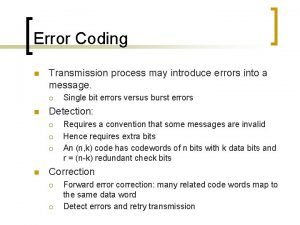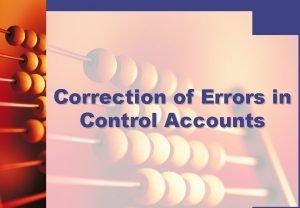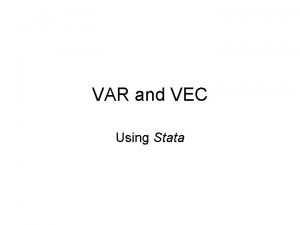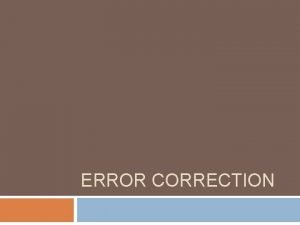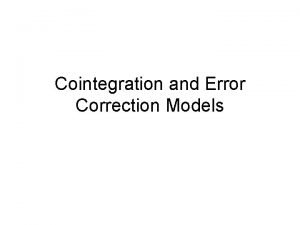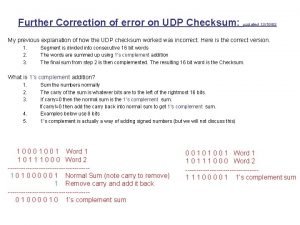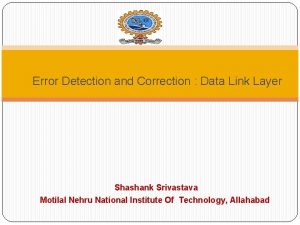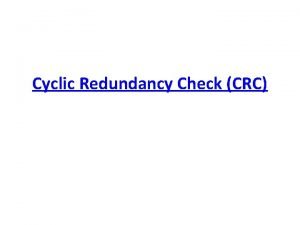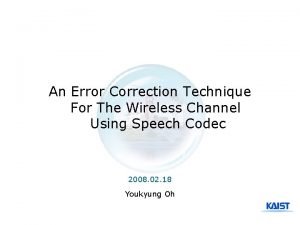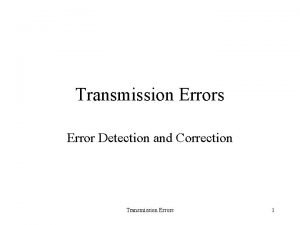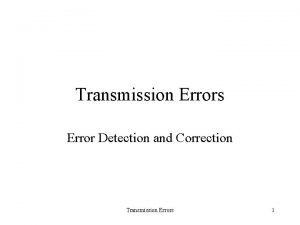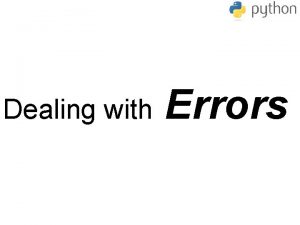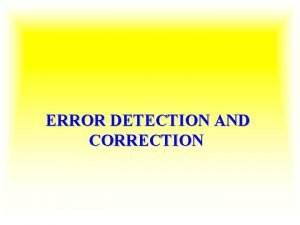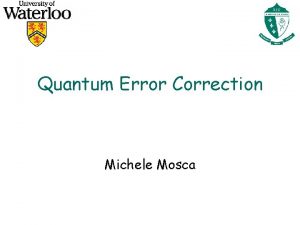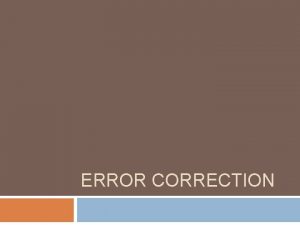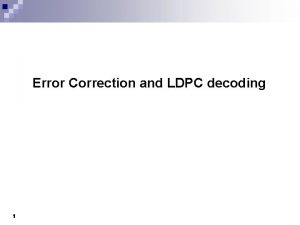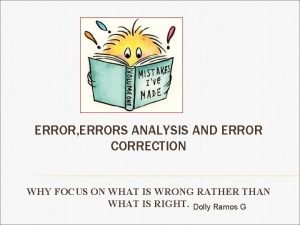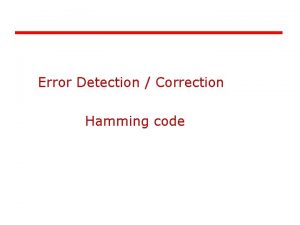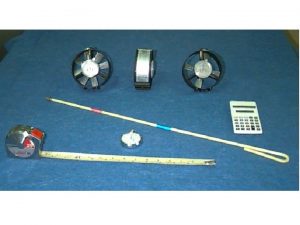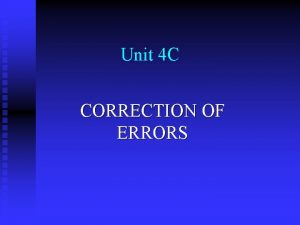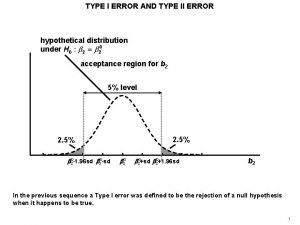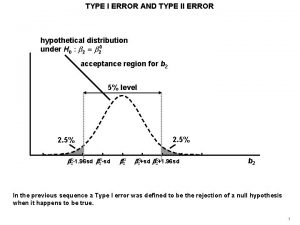Error Correction Type of error Errors where the















- Slides: 15

Error Correction

Type of error Errors where the trial balance still balances • Error of omission: A transaction has been completely omitted from the accounting records, e. g. a cash sale of Rs. 100 was not recorded. • Error of commission: A transaction has been recorded in the wrong account, e. g. rates expense of Rs. 500 has been debited to the rent account in error. • Error of principle: A transaction has conceptually been recorded incorrectly, e. g. a noncurrent asset purchase of Rs. 1, 000 has been debited to the repair expense account rather than an asset account. • Compensating error: Two different errors have been made which cancel each other out, e. g. a rent bill of Rs. 1, 200 has been debited to the rent account as Rs. 1, 400 and a casting error on the sales account has resulted in sales being overstated by Rs. 200. • Error of original entry: The correct double entry has been made but with the wrong amount, e. g. a cash sale of Rs. 76 has been recorded as Rs. 67. • Reversal of entries: The correct amount has been posted to the correct accounts but on the wrong side, e. g. a cash sale of Rs. 200 has been debited to sales and credited to bank.

Example 1 Provide the journal to correct each of the following errors: • A cash sale of Rs. 100 was not recorded. • Rates expense of Rs. 500, paid in cash has been debited to the rent account in error. • A non-current asset purchase of Rs. 1, 000 on credit has been debited to the repairs expense account rather than an asset account. • A rent bill of Rs. 1, 200 paid in cash has been debited to the rent account as Rs. 1, 400 and a casting error on the sales account has resulted in sales being overstated by Rs. 200. • A cash sale of Rs. 76 has been recorded as Rs. 67. • A cash sale of Rs. 200 has been debited to sales and credited to cash.

Type of error Errors where the trial balance does not balance • Single sided entry – a debit entry has been made but no corresponding credit entry or vice versa. • Debit and credit entries have been made but at different values. • Two debit or two credit entries have been posted. • An incorrect addition in any individual account, i. e. miscasting. • Opening balance has not been brought down. • Extraction error – the balance in the trial balance is different from the balance in the relevant account or the balance from the ledger account has been placed in the wrong column of the TB.

• If there is a difference on the trial balance, then a suspense account is used to make the total debits equal the total credits: Non-current assets Receivables Inventory Cash Payables Loan Share capital Suspense account 5, 000 550 1, 000 200 ––––– 6, 750 600 2, 000 4, 000 150 ––––– 6, 750

• The balance on the suspense account must be cleared before final accounts can be prepared. • Corrections to any of the six errors mentioned above will affect the suspense account.

Suspense accounts • A suspense account is an account in which debits or credits are held temporarily until sufficient information is available for them to be posted to the correct accounts. • There are two main reasons why suspense accounts may be created: • On the extraction of a trial balance the debits are not equal to the credits and the difference is put to a suspense account. • When a bookkeeper performing double entry is not sure where to post one side of an entry he may debit or credit a suspense account and leave the entry there until its ultimate destination is clarified.

Correction of errors When correcting errors it is useful to think about: • What double entry should have been made: • What double entry was made? • What is the correcting journal?

• For example: the purchase of a non-current asset costing Rs. 100 has been recorded by debiting Rs. 10 to the non-current assets account and crediting Rs. 100 to cash. What should the double entry have been? What was the double entry? Dr NCA Rs. 100 Dr NCA Cr Cash Rs. 100 Dr Suspense (bal. fig) Cr Cash Correcting journal Rs. 10 Dr NCA Rs. 90 Cr Suspense Rs. 90 Rs. 100

Example 2 • The debit side of a company’s TB totals Rs. 1, 200 more than the credit side. Which of the following errors would fully account for the difference? A The petty cash balance of Rs. 1, 200 has been omitted from the TB B A receipt of Rs. 1, 200 for commission receivable has been omitted from the records C Rs. 600 paid for plant maintenance has been correctly entered into the cash book and credited to the plant cost account D Discount received of Rs. 600 has been debited to the discount allowed account

Example 3 • Bond’s TB failed to agree and a suspense account was opened for the difference. Bond does not maintain control accounts for sales and purchases. The following errors were found in Bond’s accounting records: (1) In recording the sale of a non-current asset, cash received of Rs. 33, 000 was credited to the disposals account as Rs. 30, 000. (2) An opening accrual of Rs. 340 had been omitted. (3) Cash of Rs. 8, 900 paid for plant repairs was correctly accounted for in the cash book but was credited to the plant cost account. (4) A cheque for Rs. 12, 000 paid for the purchase of a machine was debited to the machinery account as Rs. 21, 000. • Which of the errors will require an entry to the suspense account to correct them?

Example 4 • On extracting a trial balance, the accountant of ETT discovered a suspense account with a debit balance of Rs. 1, 075 included therein; she also found that the debits exceeded the credits by Rs. 957. She posted this difference to the suspense account and then investigated the situation. She discovered: (1) A debit balance of Rs. 75 on the postage account had been incorrectly extracted on the list of balances as Rs. 750 debit. (2) A payment of Rs. 500 to a credit supplier, X, had been correctly entered in the cash book, but no entry had been made in the supplier’s account. (3) When a motor vehicle had been purchased during the year the bookkeeper did not know what to do with the debit entry so he made the entry Dr Suspense, Cr Bank Rs. 1, 575. (4) A credit balance of Rs. 81 in the sundry income account had been incorrectly extracted on the list of balances as a debit balance. (5) A receipt of Rs. 5 from a credit customer, Y, had been correctly posted to his account but had been entered in the cash book as Rs. 625. (6) The bookkeeper was not able to deal with the receipt of Rs. 500 from the owner’s own bank account, and he made the entry Dr Bank and Cr Suspense. (7) No entry has been made for a cheque of Rs. 120 received from a credit customer M. (8) A receipt of Rs. 50 from a credit customer, N, had been entered into his account as Rs. 5 and into the cash book as Rs. 5. • What journals are required to correct the errors and eliminate the suspense account?

Adjustments to profit • The correction journal may result in a change in profit, depending on whether the journal debits or credits the income statement: • For this purpose the suspense account is defined as a statement of financial position account. Dr Statement of financial position account Cr Statement of financial position account No impact on profit Dr Income statement account Cr Income statement account No impact on profit Dr Income statement account Cr Statement of financial position account Profit decreases Dr Statement of financial position account Cr Income statement account Profit increases

Example 5 • The following correction journals have been posted by a self-employed plumber: (1) Dr Suspense Rs. 4, 000 Cr Rent Rs. 4, 000 (2) Dr Payables Rs. 2, 500 Cr Suspense Rs. 2, 500 (3) Dr Loan interest Rs. 1, 000 Cr Loan Rs. 1, 000 (4) Dr Suspense Rs. 650 Cr Sundry income Rs. 650 (5) Dr Suspense Rs. 6, 000 Cr Cash Rs. 6, 000 • draft profit figure prior to the posting of these journals is Rs. 355, 000. • What is the revised profit figure?

Example 6 • The bookkeeping system of Turner is not computerised, and at 30 September 20 X 8 the bookkeeper was unable to balance the accounts. The trial balance totals were: Debit $1, 796, 100 Credit $1, 852, 817 • Nevertheless, he proceeded to prepare draft financial statements, inserting the difference as a balancing figure in the balance sheet. The draft profit and loss account showed a profit of $141, 280 for the year ended 30 September 20 X 8. • He then opened a suspense account for the difference and began to check through the accounting records to find the difference. He found the following errors and omissions: • $8, 980 - the total of the sales returns book for September 20 X 8, had been credited to the purchases returns account. • $49, 600 paid for an item of plant purchased on 1 April 20 X 8 had been debited to plant repairs account. The company depreciates its plant at 20% per annum on a straight line basis, with proportional depreciation in the year of purchase. • The cash discount totals for the month of September 20 X 8 had not been posted to the general ledger accounts. The figures were: Discount allowed $836 Discount received $919 • $580 insurance prepaid at 30 September 20 X 7 had not been brought down as an opening balance • The balance of $38, 260 on the telephone expense account had been omitted from the trial balance • A car held as a non-current asset had been sold during the year for $4, 800. The proceeds of sale were entered in the cash book but had been credited to the sales account in the general ledger. The original cost of the car $12, 000, and the accumulated depreciation to date $8, 000, were included in the motor vehicles account and the accumulated depreciation account. The company depreciates motor vehicles at 25% per annum on a straight line basis with proportionate depreciation in the year of purchase but none in the year of sale. • Required: (a) Open a suspense account for the difference between the trial balance totals. Prepare the journal entries necessary to correct the errors and eliminate the balance on the suspense account. Narratives are not required. (10 marks) (b) Draw up a statement showing the revised profit after correcting the above errors. (6 marks)
 Crc example
Crc example Type i error
Type i error Type 1 error vs type 2 error example
Type 1 error vs type 2 error example Alternative hypothesis
Alternative hypothesis Suspense error
Suspense error Errors that affect the trial balance
Errors that affect the trial balance Correction of errors in accounting questions
Correction of errors in accounting questions Autoregression stata
Autoregression stata Error correction adalah
Error correction adalah Error detection and correction in computer networks
Error detection and correction in computer networks Cointegration and error correction model
Cointegration and error correction model Udp error correction
Udp error correction Error detection and correction in data link layer
Error detection and correction in data link layer Crc binary division
Crc binary division Crc error detection
Crc error detection Wifi error correction
Wifi error correction
